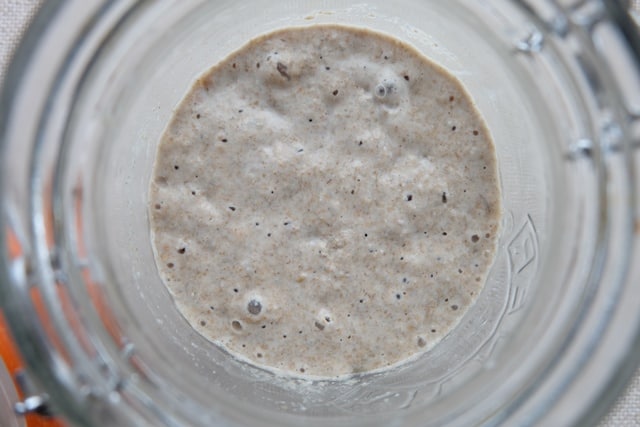The current COVID-19 related lockdown, the social distancing and self isolation measures offer for many an opportunity to dabble in sourdough baking. And with a first foray into cultivating a sourdough starter comes the need for sourdough starter troubleshooting.

This post is aimed at answering your sourdough starter questions so you can overcome any issues and problems you may encounter along the way.
Sourdough Starter Problems – Your Questions Answered
Below, you will find a list of frequently asked sourdough starter questions. If you do have additional questions, please leave a comment at the end of this post and I’ll cover the answer by updating this list of FAQs.
The following trusted book companions have helped me resolve many of my own sourdough starter problems, and as such, I’ve included some helpful suggestions from the books in the below answers:
- Do Sourdough. Slow Bread for Busy Lives. Andrew Whitley
- Bread Matters. Andrew Whitley
What ingredients do I need to make sourdough starter from scratch?
- All that is needed to produce a sourdough starter from scratch is that flour and water are combined and left in a warm place. The magic will happen from there.
- Natural yeasts and lactic acid bacteria are present in any sample of spelt, wheat or rye flour. Water and warmth provide the conditions for their growth. Flour contains everything necessary to sustain a sourdough.
- Often suggested additional ingredients such as apple, grapes, milk, pineapple juice, vinegar, yoghurt, kefir, yeast or raisins which are meant to act as aids in developing the starter, are simply not required.
- The shortest, simplest route to a sustainable sourdough is flour and water.
Sourdough starter consistency – What should it be like?
- My sourdough starter has water/liquid on top, appears to have split, the solids separating.
– If your starter hasn’t been refreshed for a while, it will look inactive (likely no bubbles) and some grey-brown liquid may have risen to the surface. This runny/watery/liquidy appearance is no cause for concern. The longer it is kept without refreshment (i.e. the process of adding flour and water after being stored in the fridge), the more likely it is to have a liquid layer. - Is my sourdough starter too wet or too thick?
– Rye starters are almost always made very wet and sloppy while wheat starters are usually more like a normal dough. - My sourdough starter has formed a crust.
– It’s likely that your sourdough starter has been left uncovered and exposed to air for too long. No harm done. Simply dispose of the crust and use the main part of the sourdough starter underneath for your refreshment i.e. add flour and water to the sourdough starter once the crust has been removed.
Is my sourdough starter ‘dead’? Has it gone bad?
- A previously viable sourdough starter which has been stored in the fridge (which can be days, weeks or months) is almost certainly not ‘dead’, even if it looks totally inactive.
- My sourdough starter is mouldy.
– In the first day or two of a starter’s life, when the lactic acid bacteria are still developing and have not produced sufficient selective anti-bacterial and anti-fungal compounds to sterilise the mixture, it is possible for moulds to get a foothold.
– In an older starter that is being kept in a tub (perhaps with an incomplete seal), moulds sometimes creep in where there is a lot of space above the starter, i.e. between its surface and the lid. This space contains enough oxygen for any moulds that may settle and multiply. The main part of the starter is usually sufficiently acid to inhibit any such growth.
– If white mould has spread, skim off the majority of the mould, then refresh the mixture by adding some fresh flour and water. Repeat if required.
– If black mould has spread over most of the starter’s surface, it is advisable to throw the starter away. If it’s just the odd spot, remove it carefully, and use some non-contaminated starter to refresh with flour and water.
– A few rounds of refreshment should allow the starter to re-establish its balance.
What to do with sourdough discard?
Ideally, you should never have to throw away any sourdough starter. If you have any leftover sourdough starter, there are plenty of ways of using this as part of other recipes e.g. muffins, crumpets, pancakes.
Read more on what to do with leftover sourdough starter over here.